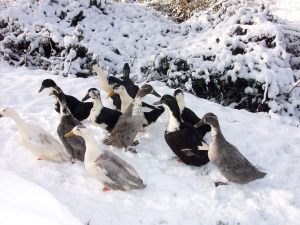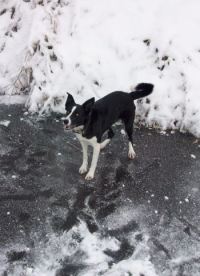 I keep an eye on sheep listed on craigslist, mostly because it’s helpful to see the price ranges out there, and how cheap a buyer could get an animal compared to what I might be wanting to charge. My opinion of animals listed on craigslist is that they are generally “bottom of the barrel” quality; with a few listings maybe being lucky hits for nicer animals that people are just clearing out of their herd for acceptable reasons. In general, it is my opinion that breeders of good animals often don’t need to advertise, especially in a forum like craigslist, because demand for their animals is already pretty high via word-of-mouth.
I keep an eye on sheep listed on craigslist, mostly because it’s helpful to see the price ranges out there, and how cheap a buyer could get an animal compared to what I might be wanting to charge. My opinion of animals listed on craigslist is that they are generally “bottom of the barrel” quality; with a few listings maybe being lucky hits for nicer animals that people are just clearing out of their herd for acceptable reasons. In general, it is my opinion that breeders of good animals often don’t need to advertise, especially in a forum like craigslist, because demand for their animals is already pretty high via word-of-mouth.
All that said, I am tempted by things I see on craigslist, especially when there are seemingly good deals, and the animals conveniently nearby. In the back of my mind, I’ve been thinking I’d like to increase my flock size a little bit more, right now, with some unrelated animals. And, with all this scrapie reading I’ve been doing, it occurred to me that if I add animals quickly, before my official start date, I’d be a little bit ahead of the game. Katahdins are not very common in our region, so this is what led me to express interest in a certain ad I spotted, offering for sale two 50% Katahdin ewes, both bred.
The advertiser explained they were mature ewes, proven breeders, good feet, one was black (I really want a black one!) and that they were bred back to a nice purebred ram. She wanted $100 apiece, which is pretty fair for middle-aged, bred ewes. None were registered, but I was thinking, that’s ok, I’ll know their breeding, and I can register the 50% offspring next year. She also mentioned she was selling them for a friend who was in over her head with her own pregnancy and needed help re-homing some animals (but was a knowledgeable and experienced breeder), and that one of the ewes was “a little thin.” Ok, so, I can deal with that, I’m graining now anyway, and ooohhh, a solid BLACK ewe!
I didn’t ask for pictures, because it all sounded good, and I didn’t think anything in a photo would convince me not to buy them. She was a 2 hour drive away, so I made a Sunday appointment to visit. Kirk decided to join me, which would turn out to be a good thing. I drove the van, brought cash, and halters and lead ropes, ready to haul them away if I/we decided to buy them.
Well, when we get there, there is a lot of hubbub and things going on-kids, pets, livestock, toys and fowl all over the place. Someone else is there with some not-very-purebred, scraggly-looking poodles, which she explains, she just procured by trading them for a saddle (and she’s got another poodle she’d like to unload, and wants to know if we’re interested in buying it off of her). This kind of thing strikes me as odd, the idea of trafficking poodles. I’m not so keen on that, coming from the venerable dog show community where a purebred dog purchase is a serious lifetime commitment. But, I let it slide, change the subject, and we go check out the sheep.
The black sheep is a cool sheep- a bit small, but otherwise nicely put together, good feet, good udder, good teeth. But, the other sheep- ooh boy, she’s not “thin,” she’s a pregnant skeleton! But some part of me says, “aw, poor thing, I can fix her…” Both sheep are flighty, ramming into gates to try to escape us, which is suddenly making me appreciate my calm and stable flock.
The lady won’t sell just the black ewe. So I tell her, well, that other sheep has no value, as I’ll have to put a lot of feed into her to bring her back, and her lamb may not survive or thrive. So, how about I pay you $100 for the black one, and I’ll take the other one off your hands as a favor? She hems and haws, she’s got money into them in feed already, she wants to recoup her investment of helping out her friend. I come up to $150 for both, but she still doesn’t bite, she’s wanting at least $175, and then, $160.
While she’s waffling over $10 increments in price negotiations, Kirk is starting to give me the kind of look that says, “let’s get out of here! This is crazy!” He says, “it’s up to you, but I don’t think this is a good idea, we don’t have the right setup to take care of that ewe…” I waver, then realize he’s right, retract my offer and thank the lady for her time. She’s lost the sale worrying about $10, which she’ll easily dump into those sheep in feed over the next week or two. But I’m relieved that her flea market haggling gave us both enough time to realize this was a dumb idea.
On the 2 hour drive home, and later, I reflect upon this decision, and that Kirk talking me out of this purchase may have averted disaster. What if that sheep had scrapie or some other contagious disease? I could have risked the health of my entire flock, trying to save a buck on some new sheep, getting lured by superficial characteristics like color, and feeling sorry for a pathetic case that needed nursing. Saving a skinny kitten or puppy is one thing, but you can’t be a softy when it comes to livestock intended for food and profit. And had passers-by seen that animal in my field, they’d question my ability to care for my animals- not good PR!
Ok, so from now on, I think I’m going to stick to slightly more expensive, but good breeders, who have an established breeding program, registered animals, are in the SFCP or NSEP, and just generally have it together, with nice, well conditioned animals to sell. No more poodle traders for me!
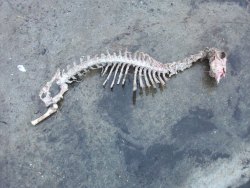 Well, it happened, and sooner than I wished: the coyotes snagged a sheep Thursday night. Of course I knew this was a possibility from the beginning, the coyotes howl in the valley every night, we see them occasionally, and I know neighbors lose livestock to them. They are definitely part of the fabric of this huge valley full of nature. Thus was the precaution of getting the llama. But, I had hopes that she’d be more effective.
Well, it happened, and sooner than I wished: the coyotes snagged a sheep Thursday night. Of course I knew this was a possibility from the beginning, the coyotes howl in the valley every night, we see them occasionally, and I know neighbors lose livestock to them. They are definitely part of the fabric of this huge valley full of nature. Thus was the precaution of getting the llama. But, I had hopes that she’d be more effective.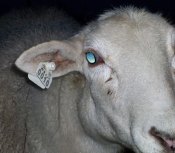 Here is the rest of the story on my final decision-making regarding scrapie programs. It turns out there is a lot written on scrapie and both the NSEP and SFCP, the information is spread out all over the place and not easy to find or understand. At first, I didn’t understand that there are two programs, so I found the phone number for my state veterinarian’s office, dialed them up and naively said “hi, I need some information on enrolling in the scrapie program.” Fortunately, I was immediately connected to Stacy Wozniak, one of the NSEP/SFCP coordinators in our state, and she was immensely helpful, and patient with my long email lists of questions. When she didn’t know the answer to a question, she found the expert who did. Over a couple of months, we got all my questions answered, and I was finally able to make an educated decision on what I wanted to do! I should also mention that Stacy was supportive and did not push me towards either option, but rather let me draw my own conclusions on what was right for me.
Here is the rest of the story on my final decision-making regarding scrapie programs. It turns out there is a lot written on scrapie and both the NSEP and SFCP, the information is spread out all over the place and not easy to find or understand. At first, I didn’t understand that there are two programs, so I found the phone number for my state veterinarian’s office, dialed them up and naively said “hi, I need some information on enrolling in the scrapie program.” Fortunately, I was immediately connected to Stacy Wozniak, one of the NSEP/SFCP coordinators in our state, and she was immensely helpful, and patient with my long email lists of questions. When she didn’t know the answer to a question, she found the expert who did. Over a couple of months, we got all my questions answered, and I was finally able to make an educated decision on what I wanted to do! I should also mention that Stacy was supportive and did not push me towards either option, but rather let me draw my own conclusions on what was right for me.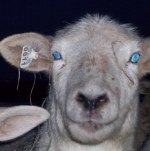 For the last several months, I’ve been reading up on the subject of scrapie in sheep, and the government-mandated programs established with the goal of eradicating scrapie in our country. First, for the uninitiated, scrapie is the form of Transmissible Spongiform
For the last several months, I’ve been reading up on the subject of scrapie in sheep, and the government-mandated programs established with the goal of eradicating scrapie in our country. First, for the uninitiated, scrapie is the form of Transmissible Spongiform  After last Thursday’s flood, our sheep are still “up top” in their little pen near the silo. They are getting tired of being up there, I’m sure. The timing was right to start graining the ewes, who are all getting big, so at least they have had something good happen in their little pen. When we’re home, we let them loose back there to graze.
After last Thursday’s flood, our sheep are still “up top” in their little pen near the silo. They are getting tired of being up there, I’m sure. The timing was right to start graining the ewes, who are all getting big, so at least they have had something good happen in their little pen. When we’re home, we let them loose back there to graze. I went out to feed the sheep at 6am this morning, and this ram lamb was dry and up running around. I found a second lamb dead, she never got the sack off of him, so he likely suffocated. She is a yearling ewe, this is her first lambing, so we can forgive her mistake. Hopefully she’ll do better next year. She seems to be caring for the live lamb well, I checked both her teats, and they are working just fine. We saw him nurse twice today, and they seem well bonded.
I went out to feed the sheep at 6am this morning, and this ram lamb was dry and up running around. I found a second lamb dead, she never got the sack off of him, so he likely suffocated. She is a yearling ewe, this is her first lambing, so we can forgive her mistake. Hopefully she’ll do better next year. She seems to be caring for the live lamb well, I checked both her teats, and they are working just fine. We saw him nurse twice today, and they seem well bonded.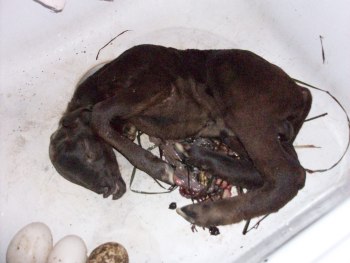
 And now, a little bit of summer. I can’t wait for the pastures and the sky to look like this again!
And now, a little bit of summer. I can’t wait for the pastures and the sky to look like this again!



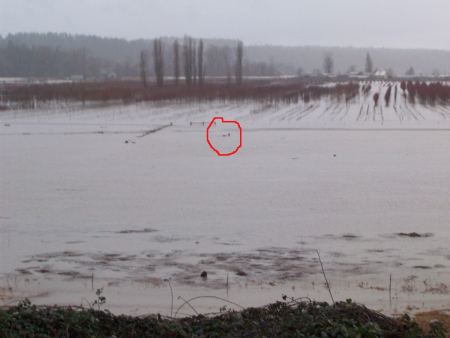
 Wow, we have a lot of snow– at least for us. I think it’s about a foot deep. Which, I’m sure, seems trivial to people in the Midwest or the East. But in the Northwest, that is a ton– I don’t have many memories of there being this much snow here in my lifetime. We’ve had snow falling for the last week, and more in the forecast for the whole next week- incredible! Usually it doesn’t stick around more than a day or two before melting into a muddy slop. Here is a panoramic photo from the pasture, in which Maggie appears twice– she got in the frame more than once!
Wow, we have a lot of snow– at least for us. I think it’s about a foot deep. Which, I’m sure, seems trivial to people in the Midwest or the East. But in the Northwest, that is a ton– I don’t have many memories of there being this much snow here in my lifetime. We’ve had snow falling for the last week, and more in the forecast for the whole next week- incredible! Usually it doesn’t stick around more than a day or two before melting into a muddy slop. Here is a panoramic photo from the pasture, in which Maggie appears twice– she got in the frame more than once!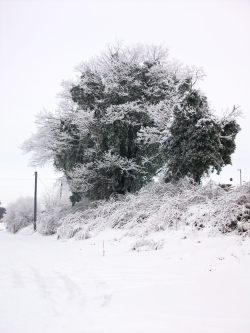 The temperatures aren’t bad– a few days it’s gotten into the teens, but it’s mostly hovering right around freezing. We got our first official complaint to animal control about our animals- from a well-meaning citizen who felt concerned for them. An animal control officer came out to investigate, and chuckled to himself, “well, the DO have wool, after all!” A friend of mine teased me that we should get wool coats for them!
The temperatures aren’t bad– a few days it’s gotten into the teens, but it’s mostly hovering right around freezing. We got our first official complaint to animal control about our animals- from a well-meaning citizen who felt concerned for them. An animal control officer came out to investigate, and chuckled to himself, “well, the DO have wool, after all!” A friend of mine teased me that we should get wool coats for them!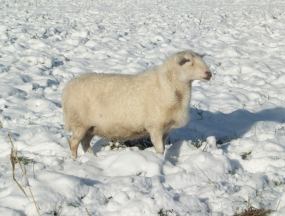 They really look like they’ve grown more wool in the last week or two, they are quite bundled up and puffy. The llama has so much wool insulating her that snow accumulates on her back and stays there– it doesn’t melt! Once a day I break the ice out of their trough with a pickaxe, though I suspect they are getting their water from eating snow and not going to the trough.
They really look like they’ve grown more wool in the last week or two, they are quite bundled up and puffy. The llama has so much wool insulating her that snow accumulates on her back and stays there– it doesn’t melt! Once a day I break the ice out of their trough with a pickaxe, though I suspect they are getting their water from eating snow and not going to the trough.